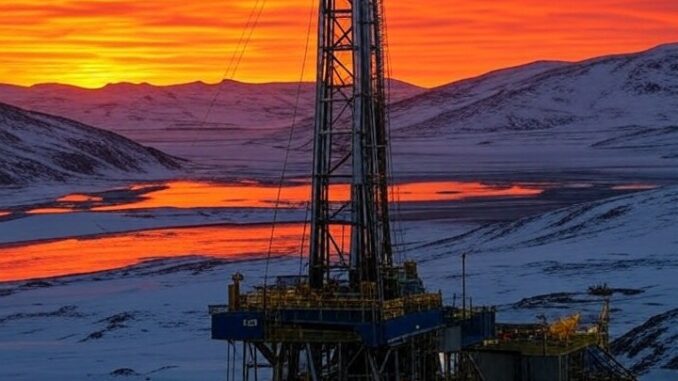
Is Oil & Gas Right for Your Portfolio?
A Game-Changer for Norway’s Arctic Ambitions
The Johan Castberg field, which began production in March 2025 after weather-related delays, is already a cornerstone of Norway’s energy strategy. With initial reserves estimated at 450–650 million barrels, Equinor aims to increase this by an additional 250–550 million barrels through continued exploration. The latest discovery is a step toward that goal, with plans for six new exploration wells and a rapid field expansion by 2028. Grete Birgitte Haaland, Equinor’s Senior Vice President for Exploration & Production North, emphasized the find’s potential: “Only a short time after Johan Castberg came on stream and is producing at full capacity, we have made a new discovery that can provide additional reserves for the field.”
The field’s strategic significance extends beyond Norway. As Western Europe’s largest oil and gas producer, Norway expects its oil liquids production to rise by 5.2% in 2025, driven largely by Johan Castberg. The field’s 30-year production life and its role in increasing Barents Sea energy deliveries by 150% solidify Norway’s position as a reliable energy supplier to Europe, especially amid global supply uncertainties.
Equinor’s success is not isolated. The company, which operates Johan Castberg with a 46.3% stake alongside partners Vår Energi (30%) and Petoro (23.7%), is part of a broader trend among oil majors investing heavily in the Arctic. The region’s untapped resources, estimated by Norwegian authorities to hold most of the country’s undiscovered petroleum, make it a high-stakes frontier for energy giants navigating volatile global markets.
Oil Majors in the Arctic: A Competitive Landscape
The Arctic has become a hotspot for oil and gas exploration, with major players like Equinor, ExxonMobil, Shell, and Russia’s Rosneft vying for dominance. Equinor’s recent discoveries, including Johan Castberg and the Fram Sør project (a $2 billion subsea development in the North Sea), reflect a strategic pivot back to its core oil and gas competencies after earlier forays into renewables. This focus aligns with Norway’s broader push to maximize Arctic production before an anticipated decline in the 2030s.
The Arctic’s harsh environment and high costs demand collaboration, yet geopolitical tensions have fractured partnerships. Historically, Western companies like ExxonMobil partnered with Rosneft in the Russian Arctic, but sanctions following Russia’s 2014 annexation of Crimea forced many to withdraw. The Ukraine war has further deepened this divide, leaving Russia to rely on domestic expertise and Chinese investment, both of which face limitations.
The Arctic’s vast resources—estimated by the U.S. Geological Survey to hold 29.4 billion barrels of untapped oil, with Alaska alone accounting for 14.46 billion—offer a potential bridge for U.S.-Russia cooperation if the Ukraine war resolves. A détente could unlock joint ventures in Arctic exploration, leveraging U.S. technology and Russian infrastructure to tap shared border regions like the Chukchi Sea. Such collaboration could stabilize global energy markets, reduce reliance on Middle Eastern supplies, and create economic incentives for both nations.
President Donald Trump, known for prioritizing energy dominance and affordable fuel, could use Arctic cooperation as a carrot to bring Russian President Vladimir Putin to the negotiation table. Trump’s recent calls for increased drilling and lower oil prices signal a willingness to engage in pragmatic energy diplomacy. Offering Russia access to U.S. Arctic expertise and markets in exchange for peace in Ukraine could align with Trump’s deal-making approach, appealing to Putin’s need to bolster Russia’s economy amid sanctions and military costs.
However, significant hurdles remain. The Ukraine war has entrenched mistrust, and any U.S.-Russia deal would face domestic opposition in both countries. Environmental groups, already critical of Arctic drilling, would likely protest expanded operations, citing risks to fragile ecosystems. Moreover, Russia’s growing reliance on China for Arctic financing could complicate Western re-engagement, as Beijing seeks to secure its own energy interests in the region.
Trump’s Leverage and the Path Forward
For Trump, Arctic energy could be a strategic bargaining chip. By framing cooperation as a win-win—offering Russia economic relief while advancing U.S. energy goals—he could incentivize Putin to negotiate an end to the Ukraine conflict. A potential framework might include:
- Joint Exploration Agreements: U.S. and Russian firms could resume partnerships in shared Arctic zones, with clear revenue-sharing and technology-transfer terms.
- Sanctions Relief: Easing restrictions on Russia’s energy sector in exchange for verifiable de-escalation in Ukraine.
- Russia’s expertise and Arctic nuclear icebreakers could also play a key role.
- Market Stabilization: Coordinated production to prevent oil price spikes, aligning with Trump’s push for affordable energy.
Such a deal would require careful diplomacy. Norway’s success in the Barents Sea provides a model for Arctic development, striking a balance between environmental concerns and economic gains. Equinor’s use of low-CO2 technologies, such as all-electric “Christmas trees” in Fram Sør, could guide U.S.-Russia projects in mitigating environmental backlash.
Conclusion
Equinor’s latest discovery in the Arctic Barents Sea highlights the region’s critical role in global energy security. As oil majors like Equinor, ExxonMobil, and Rosneft compete for Arctic dominance, the potential for U.S.-Russia cooperation looms large, contingent on a resolution to the Ukraine war. President Trump could leverage Arctic energy as a diplomatic tool, offering Putin economic incentives to facilitate peace negotiations. While challenges abound—geopolitical, environmental, and logistical—the Arctic’s vast resources present a rare opportunity for collaboration in a world that is otherwise divided. As Norway’s Johan Castberg field proves, the Arctic is not just a frontier for oil but a stage for reshaping global energy dynamics.






